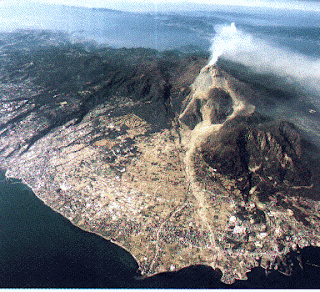VOLCANO
The volcano or volcanoes in general is a term that can be defined as a hot fluid channel system (rock in liquid form or lava) that extends from a depth of about 10 km below the surface of the earth to the earth's surface, including the sediment results in the accumulation of material released when erupted.
Furthermore, the term volcano is also used to name the phenomenon of ice formation Volcanoes or ice and mud volcanoes or volcanic mud Volcanoes. Ice volcanoes are common in areas that have a snowy winter, while the mud volcanoes can be seen in the area Kuwu, Grobogan, Central Java are popular as Bleduk * Kuwu.
Volcanoes are found worldwide, but the location of the most recognizable volcanoes are volcanoes that are along the arc of the Pacific Ring of Fire (Pacific Ring of Fire). Pacific Ring of Fire is an arc bergeseknya line between two tectonic plates.
Volcanoes are found in some form throughout their lifetime. Active volcanoes might become active half, break, before eventually becoming inactive or dead. However volcano could break in time 610 years before it became active again. Thus, it is difficult to determine the actual state rather than a volcano, the volcano is in a resting state or died.
When a volcano erupts, magma contained in the room magmar under the volcano erupted out as lava or lava. Other than the lava flows, the destruction caused by volcanoes through various ways such as the following:
Furthermore, the term volcano is also used to name the phenomenon of ice formation Volcanoes or ice and mud volcanoes or volcanic mud Volcanoes. Ice volcanoes are common in areas that have a snowy winter, while the mud volcanoes can be seen in the area Kuwu, Grobogan, Central Java are popular as Bleduk * Kuwu.
Volcanoes are found worldwide, but the location of the most recognizable volcanoes are volcanoes that are along the arc of the Pacific Ring of Fire (Pacific Ring of Fire). Pacific Ring of Fire is an arc bergeseknya line between two tectonic plates.
Volcanoes are found in some form throughout their lifetime. Active volcanoes might become active half, break, before eventually becoming inactive or dead. However volcano could break in time 610 years before it became active again. Thus, it is difficult to determine the actual state rather than a volcano, the volcano is in a resting state or died.
When a volcano erupts, magma contained in the room magmar under the volcano erupted out as lava or lava. Other than the lava flows, the destruction caused by volcanoes through various ways such as the following:
Mount Unzen, Kyushu, Japan
Unzen which consists of several overlapping stratovolcanoes in the Kyushu region, Japan. 1.500-meter-high volcano is still active today. In the lava dome collapsed tahun1792 some, causing a tsunami that killed more 15.000 people. A recent eruption in 1991, including three volcanologists killed over 40 people and caused tremendous damage to the buildings nearby.
Mauna Loa, Hawaii
Mauna Loa is the largest volcano in the world in terms of area covered and one of five volcanoes that form the Island of Hawaii in the United States and Hawaii in the Pacific Ocean. He is a shield volcano is active, with an estimated volume of about 18,000 cubic miles (75,000 km ³), [2] although its peak is about 120 feet (37 m) lower than its neighbor, Mauna Kea. Hawaiian name "Mauna Loa" means "Long Mountain". Lava eruptions from Mauna Loa are silica poor, so it is very fluid and as a result of eruptions tend to be non-explosive and the volcano is very shallow slope.
Which has probably been erupting volcano at least 700,000 years and may have emerged above sea level about 400,000 years ago, although the oldest known dated rocks do not extend beyond 200,000 years. [3] magma derived from the Hawaiian hotspot, which has the responsibility for the creation of the Hawaiian island chain for tens of millions of years. Slow passing of the Pacific Plate will eventually carry away from a hotspot volcano, and volcanoes will be extinct in 500,000 million for one year from now.
Mount Anak Krakatau
Forty-four years later was born the precursor of Anak Krakatau. Mentioned that around 1927, the fishermen who were fishing in the Strait of Sunda, was suddenly startled by the appearance of thick black smoke in the sea between the three islands that exist.
A year after the appearance of the smoke, came the Mount Anak Krakatau. Until now, Mount Anak Krakatau continues to "grow", and the height has reached 280 meters above sea level.
Nevado del Ruiz
Nevado del Ruiz is a stratovolcano located in Colombia. This mountain is a mountain located in the northernmost part of the Andean Volcanic Belt and lies about 15 miles southeast of Manizales, a town of Armero in the valley near the mountain. This mountain is the highest mountain and the mountain which lies most northerly in Colombia. This volcanic eruption in 1985 produced lava that buried the city and caused the death of 23,000 people. This event is called the tragedy of Armero. Nevado del Ruiz called the "sleeping lion" by the locals.
mont Mount Pelee
Mont Pelee is a mountain in France that erupted and destroyed the city of St. Pierre and its 30,000 citizens in 1902. [1] The volcano erupted in the morning and recorded as one of the largest volcanic eruptions of the most deadly in history other than the eruption of Krakatoa and Tambora in Indonesia. [1] St.. Pierre is a village on the island of Martinique and now a regional tourism.





No comments:
Post a Comment